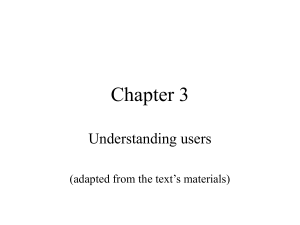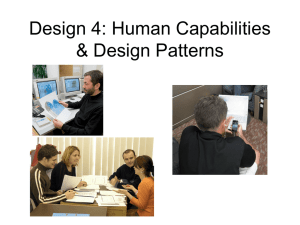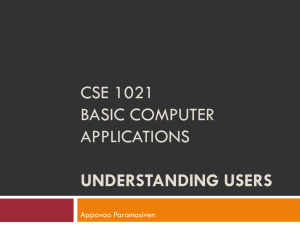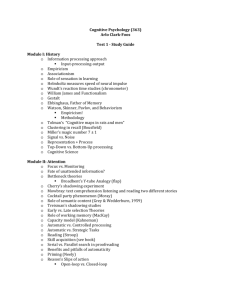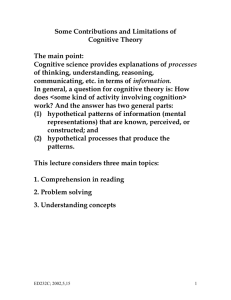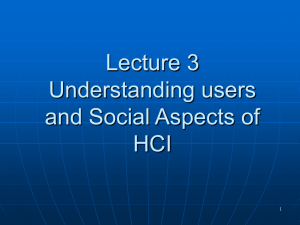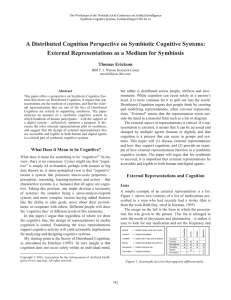Chapter 3
advertisement
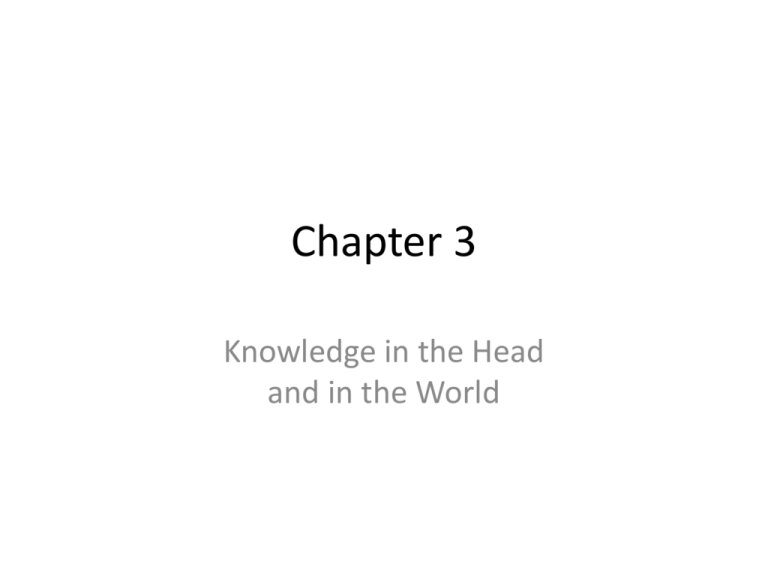
Chapter 3 Knowledge in the Head and in the World Chapter 3 • • • • • • • Precise behavior from imprecise knowledge Knowledge in head/world Memory models (short-term/long-term) Chunking and learning Distributed cognition Natural mappings and metaphors Cultural differences Precise Behavior from Imprecise Knowledge • Many decisions/actions only require rough estimates – Our minds often ignore details to achieve outcome quickly – This can be true in many cases were more precision is possible • Optimization vs. satisficing – Satisficing is often fine Good Design Requires Understanding Users • Interacting with technology is cognitive • We need to take into account cognitive processes involved and cognitive limitations of users • We can provide knowledge about what users can and cannot be expected to do • Identify and explain the nature and causes of problems users encounter • Supply theories, modelling tools, guidance and methods that can lead to the design of better interactive products What goes on in the mind? Core cognitive aspects • Attention • Perception and recognition • Memory • Reading, speaking and listening • Problem-solving, planning, reasoning and decision-making, learning • Most relevant to interaction design are attention, perception and recognition, and memory Attention • Selecting things to concentrate on at a point in time from the mass of stimuli around us • Allows us to to focus on information that is relevant to what we are doing • Involves audio and/or visual senses • Focussed and divided attention enables us to be selective in terms of the mass of competing stimuli but limits our ability to keep track of all events • Information at the interface should be structured to capture users’ attention, e.g. use perceptual boundaries (windows), color, reverse video, sound and flashing lights Activity: Find the price of a double room at the Holiday Inn in Bradley Activity: Find the price for a double room at the Quality Inn in Columbia Study Results • Tullis (1987) found that the two screens produced quite different results – 1st screen - took an average of 5.5 seconds to search – 2nd screen - took 3.2 seconds to search • Why, since both displays have the same density of information (31%)? • Spacing – In the 1st screen the information is bunched up together, making it hard to search – In the 2nd screen the characters are grouped into vertical categories of information making it easier Design implications for attention • Make information salient when it needs attending to • Use techniques that make things stand out like color, ordering, spacing, underlining, sequencing and animation • Avoid cluttering the interface - follow the google.com example of crisp, simple design • Avoid using too much because the software allows it An example of over-use of graphics Perception and recognition • How information is acquired from the world and transformed into experiences • Obvious implication is to design representations that are readily perceivable, e.g. – Text should be legible – Icons should be easy to distinguish and read Which is easiest to read and why? What is the time? What is the time? What is the time? What is the time? What is the time? Design implications • Representations of information need to be designed to be perceptible and recognizable • Icons and other graphical representations should enable users to readily distinguish their meaning • Bordering and spacing are effective visual ways of grouping information • Sounds should be audible and distinguishable • Speech output should enable users to distinguish between the set of spoken words • Text should be legible and distinguishable from the background External cognition • Concerned with explaining how we interact with external representations (e.g. maps, notes, diagrams) • What are the cognitive benefits and what processes involved • How they extend our cognition • What computer-based representations can we develop to help even more? Externalizing to reduce memory load • Diaries, reminders, calendars, notes, shopping lists, to-do lists written to remind us of what to do • Post-its, piles, marked emails - where placed indicates priority of what to do • External representations: – Remind us that we need to do something (e.g. to buy something for mother’s day) – Remind us of what to do (e.g. buy a card) – Remind us when to do something (e.g. send a card by a certain date) Computational offloading • When a tool is used in conjunction with an external representation to carry out a computation (e.g. pen and paper) • Try doing the two sums below (a) in your head, (b) on a piece of paper and c) with a calculator. – 24 x 46 =?? – XXIIII x XXXXVI = ??? • Which is easiest and why? Both are identical sums Annotation and cognitive tracing • Annotation involves modifying existing representations through making marks – e.g. crossing off, ticking, underlining • Cognitive tracing involves externally manipulating items into different orders or structures – e.g. playing scrabble, playing cards Design implication • Provide external representations at the interface that reduce memory load and facilitate computational offloading e.g. Information visualizations have been designed to allow people to make sense and rapid decisions about masses of data Memory • Involves first encoding and then retrieving knowledge • We don’t remember everything - involves filtering and processing what is attended to • Context is important in affecting our memory (i.e., where, when) • Well known fact that we recognize things much better than being able to recall things – Better at remembering images than words – Why interfaces are largely visual Processing in memory • Encoding is first stage of memory – determines which information is attended to in the environment and how it is interpreted • The more attention paid to something, – And the more it is processed in terms of thinking about it and comparing it with other knowledge, – The more likely it is to be remembered • e.g., when learning about HCI, it is much better to reflect upon it, carry out exercises, have discussions with others about it, and write notes than just passively read a book, listen to a lecture or watch a video about it Context is important • Context affects the extent to which information can be subsequently retrieved • Sometimes it can be difficult for people to recall information that was encoded in a different context – e.g., You are on a train and someone comes up to you and says hello. You don’t recognize him for a few moments but then realize it is one of your neighbors. You are only used to seeing your neighbor in the hallway of your apartment block and seeing him out of context makes him difficult to recognize initially Recognition versus recall • Command-based interfaces require users to recall from memory a name from a possible set of 100s • GUIs provide visually-based options that users need only browse through until they recognize one • Web browsers, MP3 players, etc., provide lists of visited URLs, song titles etc., that support recognition memory The problem with the classic ‘72’ • George Miller’s theory of how much information people can remember • People’s immediate memory capacity is very limited – Norman’s approximation is 5 items • Many designers have been led to believe that this is useful finding for interaction design What some designers get up to… • • • • • Present only 7 options on a menu Display only 7 icons on a tool bar Have no more than 7 bullets in a list Place only 7 items on a pull down menu Place only 7 tabs on the top of a website page – But this is wrong? Why? Why? • Inappropriate application of the theory • People can scan lists of bullets, tabs, menu items till they see the one they want • They don’t have to recall them from memory having only briefly heard or seen them • Sometimes a small number of items is good design • But it depends on task and available screen estate Design implications • Don’t overload users’ memories with complicated procedures for carrying out tasks • Design interfaces that promote recognition rather than recall • Provide users with a variety of ways of encoding digital information to help them remember where they have stored them – e.g., categories, color, flagging, time stamping Knowledge in the World vs Knowledge in the Mind • In the World – Uses signifiers, relies on recognition, easier for novices, can create clutter • In the Mind – Uses memory, relies on recall, efficient for experts, opens up design space Learning • Distinguish between acquiring information (data) and acquiring skills (process) • Learning by rote vs. learning with understanding – Rote learning can be regurgitated but not used as tool – Learning with understanding is faster, lasts longer, and is more generally applicable • Differences in indexing, redundancy, and representation • How many stars were on the US flag in 1940? – How did you answer that? Information processing • Conceptualizes human performance in metaphorical terms of information processing stages Human Processor Model (Card et al, 1983) • Models the information processes of a user interacting with a computer • Predicts which cognitive processes are involved when a user interacts with a computer • Enables calculations to be made of how long a user will take to carry out a task The human processor model Distributed cognition • Concerned with the nature of cognitive phenomena across individuals, artefacts, and internal and external representations (Hutchins, 1995) • Describes these in terms of propagation across representational state • Information is transformed through different media (computers, displays, paper, heads) How it differs from information processing What’s involved • The distributed problem-solving that takes place • The role of verbal and non-verbal behavior • The various coordinating mechanisms that are used (e.g., rules, procedures) • The communication that takes place as the collaborative activity progresses • How knowledge is shared and accessed Key points • Cognition involves several processes including attention, memory, perception and learning • The way an interface is designed can greatly affect how well users can perceive, attend, learn and remember how to do their tasks • Theoretical frameworks such as mental models and external cognition provide ways of understanding how and why people interact with products, which can lead to thinking about how to design better products Chapter 3 • • • • • • • Precise behavior from imprecise knowledge Knowledge in head/world Memory models (short-term/long-term) Chunking and learning Distributed cognition Natural mappings and metaphors Cultural differences

